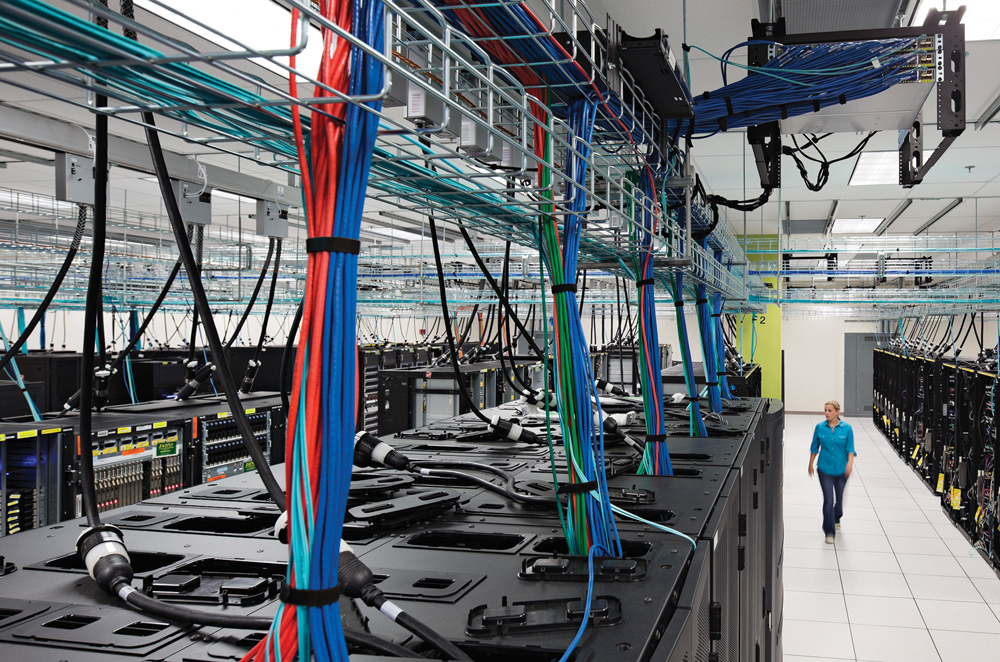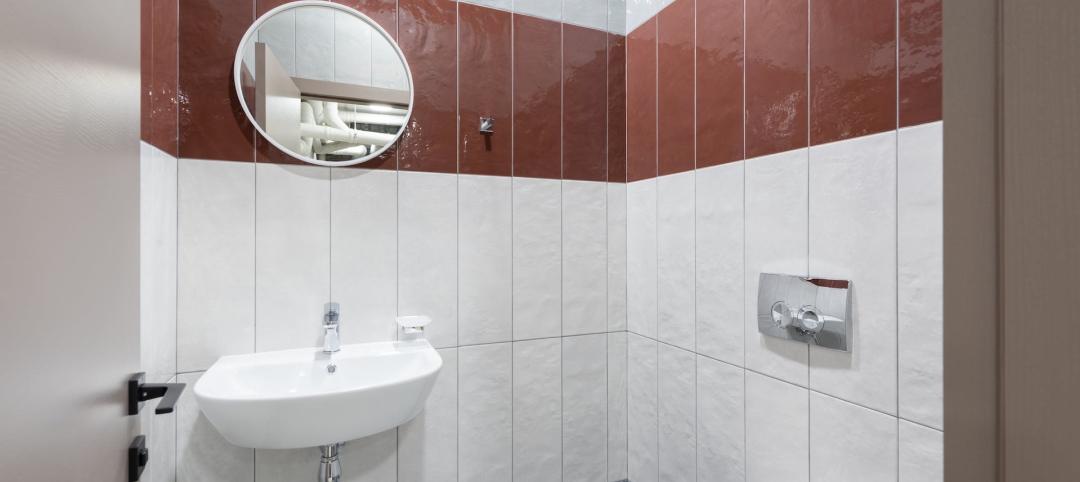While the once white-hot data center construction market has cooled off in recent years, the outlook for this sector remains quite rosy. Each year, businesses and institutions spend billions on data center construction and retrofit projects to keep up with the nation’s insatiable demand for data storage and processing.
The data center sector is conservatively estimated at $13-15 billion annually—larger than the hospitality, amusement/recreation, and water supply sectors, according to U.S. Census Bureau data. And the emergence of cloud computing and storage, combined with the “never delete anything” mindset of consumers and businesses, will only drive demand for data storage and processing.
“The data center market should generally follow the growth of Internet traffic, and Internet traffic continues to grow strongly,” says Craig Deering, AIA, LEED AP, National Practice Leader – Critical Facilities with HDR Architecture.
According to a May 2013 report from Cisco Systems, IP traffic volume in North America is expected to grow to 40 exabytes a month by 2017, a 23% cumulative annual growth rate. Cisco predicts global IP traffic will increase threefold over the next five years. Driving this steep growth are the explosion of networked devices, especially wireless gadgets, and the emergence of video as a dominant content type. Cisco predicts that traffic from wireless and mobile devices will exceed wired devices by 2016, and video will reach 69% of global consumer Internet traffic by 2017.
TOP DATA CENTER ARCHITECTURE FIRMS
2012 Data Center Revenue ($)1 Corgan $27,534,1912 Gensler $23,330,0003 HDR Architecture $16,295,0004 Integrated Design Group $14,598,9105 PageSoutherlandPage $14,450,0006 Reynolds, Smith and Hills $4,360,0007 Callison $3,973,6998 Little $3,655,5909 RTKL Associates $3,634,00010 EwingCole $3,000,000
TOP DATA CENTER ENGINEERING FIRMS
2012 Data Center Revenue ($)1 Fluor $235,678,9002 Syska Hennessy Group $36,735,4343 Jacobs Engineering Group $36,700,0004 H&A Architects & Engineers $35,427,5995 URS Corp. $26,229,0496 Environmental Systems Design $10,575,8927 Parsons Brinckerhoff $10,300,0008 H.F. Lenz $7,357,0009 Science Applications International Corp. $6,760,59810 AKF Group $6,602,000
TOP DATA CENTER CONSTRUCTION FIRMS
2012 Data Center Revenue ($)1 DPR Construction $895,882,4592 Balfour Beatty $753,194,2143 Holder Construction $710,000,0004 Turner Corporation, The $501,750,0005 Whiting-Turner Contracting Co., The $490,093,0456 Mortenson Construction $307,360,0007 Structure Tone $285,725,0008 Skanska USA $236,396,8589 Gilbane $130,362,00010 Carlson Design Construct $128,000,000
Giants 300 coverage of Data Centers brought to you by System Sensor www.systemsensor.com
What does this mean in terms of construction spending growth? If the Data Center Dynamics annual census of the industry is any indication, the data center construction market will remain one of the fastest-growing sectors in the country. According to DCD Intelligence’s most recent survey of nearly 3,800 data center owner/operators and 1,600 vendors, data center facility investment was up 23% on the Coasts and 50% in the central U.S. in 2011-12.
“Calculating the size of the data center market is challenging,” says Deering, “but no matter how you look at it, there’s no doubt that the data center market stands on its own as a distinct and meaningful sector.”
Achieving a lower cost of computing
Shrinking IT budgets and rising operational costs have led data center operators and corporate clients to scrutinize project budgets. As a result, AEC firms are being tasked with finding solutions for lowering the overall cost of computing and operating and maintaining the facilities.
This, in turn, is driving innovation in data center design, including the use of advanced cooling schemes, energy-efficient IT equipment, and higher-density environments. Advanced technologies like KyotoCooling, which utilizes heat wheels to reduce the cooling load on the building’s HVAC system, are becoming more common in U.S. data center projects. In addition, a growing number of data center operators are choosing to build new facilities in northern climates to take advantage of the cooler outdoor air temperatures.
Advancements in server technology, combined with a recent change to ASHRAE’s TC 9.9 Datacom guidelines, means that Building Teams can deliver facilities that operate at higher internal temperatures, greatly reducing cooling costs.
“The top end of the allowable range now is 80.6°F, up from 76°F previously,” says Ronald Vokoun, DBIA, LEED AP BD+C, Mission Critical Market Leader – Western Region with JE Dunn Construction. “Generally speaking, for every 1.8°F that you raise the temperature in your data center, you save 2-4% of your total energy bill. That’s a pretty high and immediate ROI.”
Rising costs are forcing many companies to outsource their data hosting through co-location and cloud services. This trend is leading to the construction of more mega-data center facilities, like CyrusOne’s new Chandler, Ariz., complex, which will eventually house more than
1 million sf of data center space. By 2015, just 2% of the world’s data centers will contain 60% of the floor space, up from 52% in 2010, according to a report from Gartner Inc.
“We will continue to see the concentration of data center floor space into a small community of dominant global players,” says HDR’s Deering.
Retrofits: A growth market
An emerging market for AEC firms is data center retrofits. The first wave of data centers—built during the dot-com boom of the late 1990s—are woefully outdated and are prime for retrofitting. Even the facilities built years later are behind the technology curve, and operators will be looking to upgrade their servers and infrastructure to meet the computing demands of today’s market.
“Many companies are looking at the ‘capex’ versus ‘opex’ dollars and realizing that they can strike a meaningful balance between the two by simply updating, retrofitting, or renovating their existing facilities,” says Jerry Sumrell, PE, Vice President, Mission Critical with RS&H. “This presents new challenges to the design industry, as we will be devoting more time to working in live data center environments with all of the associated risks that come with it. It’s akin to performing open-heart surgery—you have to keep the facility running 24/7 while adding new equipment, decommissioning existing equipment, and transferring power/cooling from one piece of equipment to another.”
Read BD+C's full Giants 300 Report
Related Stories
MFPRO+ News | Feb 15, 2024
Nine states pledge to transition to heat pumps for residential HVAC and water heating
Nine states have signed a joint agreement to accelerate the transition to residential building electrification by significantly expanding heat pump sales to meet heating, cooling, and water heating demand. The Memorandum of Understanding was signed by directors of environmental agencies from California, Colorado, Maine, Maryland, Massachusetts, New Jersey, New York, Oregon, and Rhode Island.
MFPRO+ News | Feb 15, 2024
Oregon, California, Maine among states enacting policies to spur construction of missing middle housing
Although the number of new apartment building units recently reached the highest point in nearly 50 years, construction of duplexes, triplexes, and other buildings of from two to nine units made up just 1% of new housing units built in 2022. A few states have recently enacted new laws to spur more construction of these missing middle housing options.
Green | Feb 15, 2024
FEMA issues guidance on funding for net zero buildings
The Federal Emergency Management Agency (FEMA) recently unveiled new guidance on additional assistance funding for net zero buildings. The funding is available for implementing net-zero energy projects with a tie to disaster recovery or mitigation.
Hospital Design Trends | Feb 14, 2024
Plans for a massive research hospital in Dallas anticipates need for child healthcare
Children’s Health and the UT Southwestern Medical Center have unveiled their plans for a new $5 billion pediatric health campus and research hospital on more than 33 acres within Dallas’ Southwestern Medical District.
K-12 Schools | Feb 13, 2024
K-12 school design trends for 2024: health, wellness, net zero energy
K-12 school sector experts are seeing “healthiness” for schools expand beyond air quality or the ease of cleaning interior surfaces. In this post-Covid era, “healthy” and “wellness” are intersecting expectations that, for many school districts, encompass the physical and mental wellbeing of students and teachers, greater access to outdoor spaces for play and learning, and the school’s connection to its community as a hub and resource.
Codes | Feb 9, 2024
Illinois releases stretch energy code for building construction
Illinois is the latest jurisdiction to release a stretch energy code that provides standards for communities to mandate more efficient building construction. St. Louis, Mo., and a few states, including California, Colorado, and Massachusetts, currently have stretch codes in place.
Market Data | Feb 7, 2024
New download: BD+C's February 2024 Market Intelligence Report
Building Design+Construction's monthly Market Intelligence Report offers a snapshot of the health of the U.S. building construction industry, including the commercial, multifamily, institutional, and industrial building sectors. This report tracks the latest metrics related to construction spending, demand for design services, contractor backlogs, and material price trends.
Retail Centers | Feb 4, 2024
‘Safe bathroom’ technology prevents fatal drug overdoses in public restrooms
‘Safe bathroom’ technology developed by a Massachusetts electrician has been proven to prevent fatal drug overdoses in public restrooms across the country. The systems use ultrasonic and infrared motion sensors connected to timers that detect slight body movements. When a system doesn’t sense motion within a set time period, it raises an alarm alerting emergency medical teams.
Standards | Feb 1, 2024
Prioritizing water quality with the WELL Building Standard
In this edition of Building WELLness, DC WELL Accredited Professionals Hannah Arthur and Alex Kircher highlight an important item of the WELL Building Standard: water.
Industry Research | Jan 23, 2024
Leading economists forecast 4% growth in construction spending for nonresidential buildings in 2024
Spending on nonresidential buildings will see a modest 4% increase in 2024, after increasing by more than 20% last year according to The American Institute of Architects’ latest Consensus Construction Forecast. The pace will slow to just over 1% growth in 2025, a marked difference from the strong performance in 2023.

















